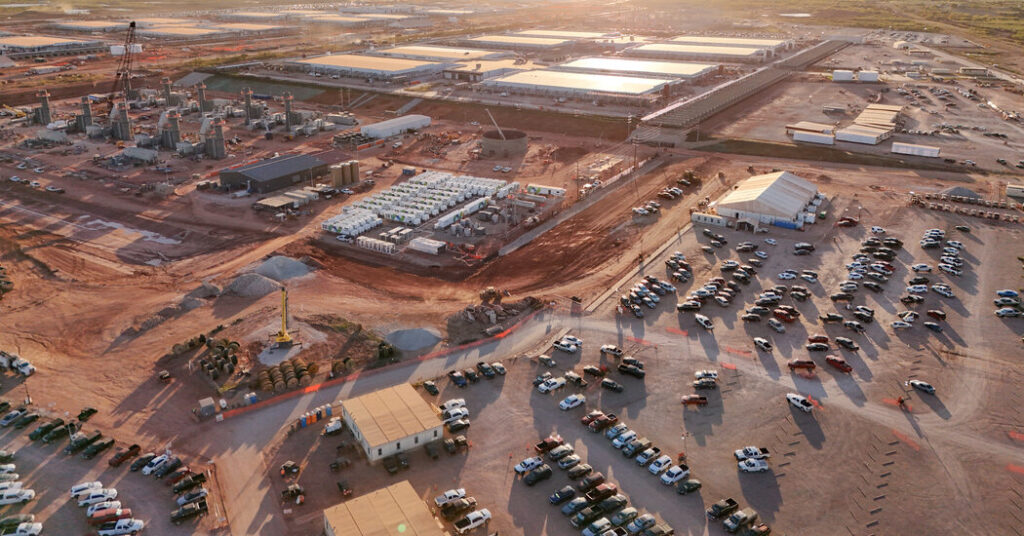It would not be a stretch to describe this period of hyperactive growth in the tech industry as a historic moment.
Nvidia, which makes computer chips that are essential to building artificial intelligence, said on Wednesday that its quarterly profit jumped to nearly $32 billion, up 65 percent from a year ago and 245 percent from the year before that.
Just three weeks ago, Nvidia became the first publicly traded company to be worth $5 trillion. Microsoft, Google, Apple and Amazon are also now valued in the trillions. In their most recent quarters, the four companies reported more than $110 billion in combined profits.
“There’s been a lot of talk about an A.I. bubble,” said Jensen Huang, Nvidia’s chief executive, after his company’s blowout quarterly report. “From our vantage point, we see something very different.”
But some industry insiders say there is something ominous lurking behind all this bubbly news. They look at the same eye-popping growth and the same stunning wealth creation as Mr. Huang and see a house of cards. And they say it is hard to know what the damage will be if it collapses.
Even Nvidia’s growth can be explained away. Demand for the company’s chips doesn’t mean people want to use A.I. It merely means that companies are building giant A.I. systems in hopes someone will pay to use them. The Nvidia-led rally on Wall Street lasted only a few hours, after all, and the company’s share price was down about 3 percent at the end of trading on Thursday. A sharp reversal in tech stocks pulled the whole market lower, with the S&P 500 dropping 1.6 percent for the day.
The heart of the pessimist’s case against the A.I. boom, however, is the money pouring into the start-up world and the billions upon billions those companies are spending on data centers.
OpenAI, the company that kicked off the boom three years ago, is now worth an estimated $500 billion, making it the most valuable start-up in the world. Anthropic, OpenAI’s archrival, is now worth an estimated $183 billion. And Thinking Machines Labs, which was started in February, is already believed to be valued in the tens of billions of dollars.
OpenAI is not profitable and doesn’t expect to be until 2030. Anthropic is also in the red. Thinking Machines just put out its first product.
That hasn’t stopped them from spending. Anthropic recently said it would invest $50 billion in new data centers. Sam Altman, OpenAI’s celebrity chief executive, said his company was committed to spending $1.4 trillion on computing power for its A.I. pursuits.
“What OpenAI is engaged in is the most dramatic case of ‘Fake It Until You Make It’ that we have ever seen,” said Gil Luria, head of technology research at D.A. Davidson. “They are making huge commitments that they literally can’t afford.”
OpenAI and its partners are pumping $500 billion into new data centers in the United States as part of what they call Project Stargate. In today’s dollars, that is enough to fund the Manhattan Project 15 times over. It could pay for the entire Apollo moon project. Twice.
“Stargate alone — if it does actually reach $500 billion — would be the largest infrastructure project in the world, several time over,” said Evan Conrad, chief executive of San Francisco Compute, a start-up that specializes in hardware for A.I.
An OpenAI spokesman said in a statement that the company believed its trajectory was heading in the right direction, with 800 million weekly users and more than a million business users.
“Progress in generational advancements — like railroads, electricity and the internet — comes from bold investment and long-term conviction,” said the spokesman, Steve Sharpe. “In under three years we’ve built the fastest-growing consumer and enterprise platform in history.”
Tech companies, governments and their partners around the world will spend nearly $3 trillion on data centers by 2028, according to analysts at Morgan Stanley. To make that happen, they will borrow nearly a trillion dollars from banks and other financial institutions.
Over the last 12 months, Google, Microsoft, Amazon and Meta spent about $360 billion on new data centers. With their huge profits, they can afford it. Other companies have to take on debt. That includes established companies like the software maker Oracle and smaller outfits with names like CoreWeave and Nebius.
Because that debt is held by a wide array of financial institutions — including private credit lenders as well as traditional banks — experts are struggling to understand how much risk is in the system.
Adding to worries, critics say some of the deals OpenAI has made with chipmakers, cloud computing companies and others are oddly circular. OpenAI is set to receive billions from tech companies but also sends billions back to the same companies to pay for computing power and other services.
Some financial analysts worry that these deals make the market look stronger than it really is. Ultimately, the health of the market will depend on whether companies like OpenAI can turn a profit before debt overwhelms them.
(The New York Times has sued OpenAI and Microsoft, claiming copyright infringement of news content related to A.I. systems. The two companies have denied the suit’s claims.)
Nvidia has also made some deals that have raised questions about whether the company is paying itself. It announced that it would invest $100 billion in OpenAI. The start-up receives that money as it buys or leases Nvidia’s chips.
On Tuesday, Nvidia announced a similar $10 billion deal with Anthropic, which will buy $30 billion in A.I. computing backed by Nvidia chips. That money will actually go to buy computing power from Microsoft, which also invested $5 billion in Anthropic.
Goldman Sachs has estimated that Nvidia will make 15 percent of its sales next year from what critics also call circular deals.
Many companies justify their spending because they’re not just building a product, they’re creating something that will change the world: artificial general intelligence, or A.G.I., a machine that can do anything the human brain can do. The rub is that none of them quite know how to do it.
But Anton Korinek, an economist at the University of Virginia, said the spending will all be justified if Silicon Valley reaches its goal. He is optimistic it can be done.
“It’s a bet on A.G.I. or bust,” Dr. Korinek said.
A.I. company’s chatbots and image generators are already being used by hundreds of millions of people. Many of them pay monthly fees that can top $100. But it’s not so clear that business customers — the real cash cow for the tech industry — are as keen to use A.I.
Nearly eight in 10 businesses have said they have not yet used A.I. technologies. Just as many have said these technologies had “no significant bottom-line impact,” according to recent research from McKinsey & Company.
Nonetheless, tech companies say business interest is starting to congeal. Microsoft, Google and Amazon all said they have more customer demand than available supply and they expect to be constrained into next year.
Even among some executives of Silicon Valley’s wealthiest companies, however, the money sloshing around is worrying.
Sundar Pichai, the chief executive of Alphabet, Google’s parent company, said in an interview with the BBC this week that the spending and skyrocketing valuations were driven at least in part by “irrationality.” If the market crashes, he said, the damage will be widespread. “I think no company is going to be immune, including us,” he said.
Tech industry veterans often compare the A.I. boom to the dot-com bubble of the 1990s. When that bubble burst, hundreds of start-ups disappeared and established companies that were selling technology to those young outfits experienced huge losses. But other start-ups found lasting success and did, in fact, change the world — most notably Amazon and Google.
“When bubbles happen, smart people get over-excited about a kernel of truth,” Mr. Altman told reporters earlier this year. “Are we in a phase where investors as a whole are over-excited about A.I.? My opinion is yes. Is A.I. the most important thing to happen in a very long time? My opinion is also yes.”
Cade Metz is a Times reporter who writes about artificial intelligence, driverless cars, robotics, virtual reality and other emerging areas of technology.
The post The A.I. Boom Has Found Another Gear. Why Can’t People Shake Their Worries? appeared first on New York Times.




